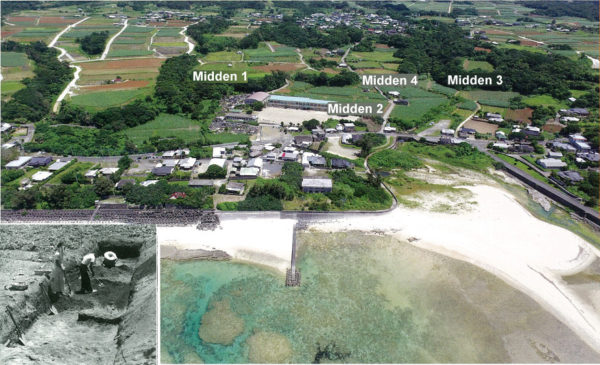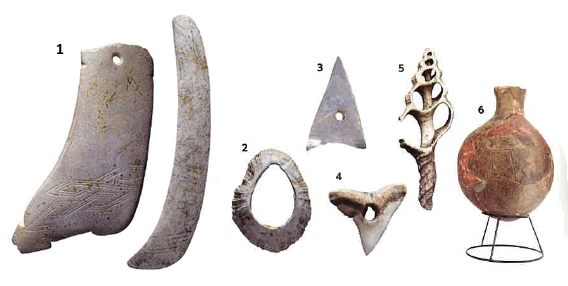Izen Town, Kagoshima Prefecture
Early Jōmon–Medieval periods (approximately 7,000 years before the present–sixteenth century CE)

Panorama of the site (photo courtesy Arch Inc.)
Located on a sand dune 8 m in elevation at the foot of a limestone bluff, with a shallow coral reef sea spreading out on its southern side. Midden 1 was discovered in 1928 and Midden 2 in 1930, and investigations resumed with the return of the Amami Islands to Japan in the postwar period. From 1956, investigations were carried out by the Kyūgakkai Rengō (Council of Nine Learned Societies, a link of academic organizations in anthropology, ethnology, folklore, sociology, archaeology, linguistics, geography, religious studies, and psychology), and Middens 3 and 4 were verified. Adapted from Hakkutsu sareta Nihon rettō 2017 [Excavations in the Japanese Archipelago, 2017] (Bunkachō [Agency for Cultural Affairs], ed., Kyodo News, 2017).
(inset) Excavation of 1956 (Midden 2)
Excavation of 2002 (Midden 2)
A settlement of the Late Jōmon period (approximately 3,500 years ago) was found under the playground of an elementary school. Beneath the playground fill were strata of sand, and traces were confirmed of the daily life of people from that era who made buildings and hearths atop a sand dune 3–4 m in elevation.
Stone cluster (Midden 2)
Various stones both large and small were gathered together in a circular hole dug down about 50 cm. The width of the hole was about 2.4 m. Dark sand mixed with charcoal was found in the gaps between the stones, and the feature is thought to have been a hearth for using fire.
A variety of artifacts were recovered from the Early Jōmon to the Ancient periods, including pottery, stone tools, and objects fashioned from shell. There are similarities with materials of the Ryūkyū archipelago, and it was concluded that while the Amami Islands and the Ryūkyūs had similar cultures, each had its own particular characteristics.

1. Objects made of shell
Portions of shell from a giant clam (family Tridacnidae) fashioned in the shape of a sickle and engraved with a distinctive linear design shared with pottery of the Late and Final Jōmon periods. As these were found together with human bone, they are regarded as mortuary items from a grave. The object at left is 12 cm long, and the one at right is 16 cm.
2. Shell bracelet
A bracelet made from a limpet shell. Length: 7.5 cm.
3. Shell object in the shape of a projectile point
Made of green turban shell. Length: 2.9 cm.
4. Object fashioned from a shark’s tooth
An ornamental object that can be dangled like a pendant. Length: 0.8 cm; thickness: 0.1 cm.
5. Object made of shell
Made by cutting away the body of a spiral shell. It is thought to have been used as an ornament. Surviving length: 10.1 cm.
6. Pot
Recovered from a sarcophagus grave at Midden 1. Vessel height: approx. 23 cm; greatest diameter: approx. 18 cm.
Nearly 90 years past the discovery, new facts come to light
An excavation of lasting historic import
The Omonawa shell middens comprise a settlement site centering on the Late Jōmon period (approximately 3,500 years before the present; equivalent to Kaizuka Early Phase 4 in the periodization for the Amami/Okinawa region), and spanning the Early Jōmon (about 7,000 years ago; Kaizuka Early Phase 1) to the Medieval (ca. sixteenth century; Ryūkyū Kingdom) periods. Located near the southernmost portion of Tokunoshima Island, its position on a coastal sand dune beneath a hillside bluff of Ryūkyū limestone is an example of land utilization frequently seen for the prehistoric age (Jōmon–Ancient periods) in the Ryūkyū archipelago.
From the time of its discovery in 1928, investigations have been carried out by prominent archaeologists and physical anthropologists, with four separate locations (Middens 1–4) verified in the vicinity of Omonawa Elementary School, having traces of daily life such as buildings, hearths, and shell middens, plus burial remains utilizing caves and rock shelters being found. In prewar investigations, pottery with similarities to southern Kyushu of the Jōmon period and the Ryūkyū archipelago was discovered, and the Amami Islands drew attention as an important region linking relations between the two. This pottery was later given the type names Omonawa Zentei, Omonawa Tōdō, Omonawa Seidō, and Kaneku, and is regarded as basic material for the ceramic chronology of the Ryūkyū archipelago.
In the postwar period, based on the Omonawa finds along with the results of excavations conducted at the Historic Sites of Ushuku Shell Midden (on the island of Amami Ōshima) and Sumiyoshi Shell Midden (on the island of Okinoerabujima), the Kyūgakkai Rengō (Council of Nine Learned Societies) concluded that a highly unique culture flourished in the Amami Islands, linked with the Jōmon culture of southern Kyushu.
The way of daily life becomes clear
Although it was thought that all four locations had been thoroughly excavated, discoveries in investigations from the mid 1970s included a stone cluster regarded as a hearth, and a burial in a sarcophagus made by lining up stones. During excavations from 2007 to 2015, it became clear that the extent of the site was greater than previously thought, and transitions in the site’s location and the process of its formation became apparent. In particular, in an investigation of Omonawa Midden 2 in 2002, along with pottery and shell products the remains of eight buildings, a stone-paved feature and six stone clusters (all regarded as hearths), plus two pits thought to have been places for disposal were ascertained, bringing to light the daily life of people of the Late Jōmon, the central period of the site.
In addition, based on identifications of the recovered shellfish and fish species, the majority were varieties that inhabit coral reefs. To sum up the results of the investigations, around 3,500 years before the present the site spread out facing the seacoast on its southern side. That was around the time of formation of the sand dune and reef lagoon visible today, which becomes a shallow pool at low tide, and it is thought that with the formation of the lagoon, people likely moved the base of their daily living to the sand dune near the sea, making utilization of the lagoon more convenient. (Shinzato Akito)

